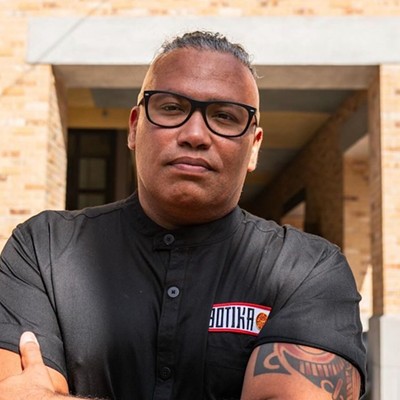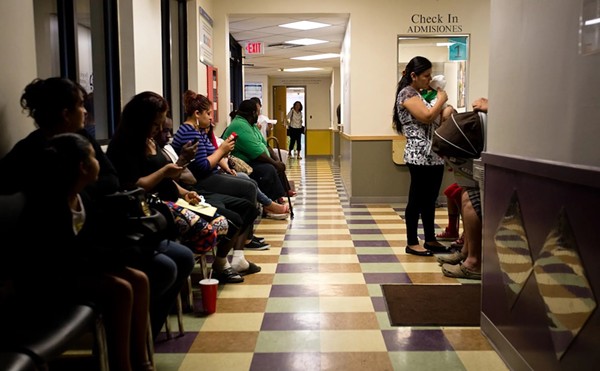On July 10, a white Bengal tiger named Vi Vi died at the Wild Animal Orphanage, a sanctuary for retired research primates, discarded big-game pets, and an assortment of other castoffs located in Northwest Bexar County. Less than a year old, she had arrived at the orphanage in February from the Rio Grande Valley to some minor media fanfare, during which WAO’s veterinarian reported that “Vi Vi appears to be in good health.”
Then, just a few months later, she was gone. Vi Vi was hardly the first animal to die at the Orphanage under curious circumstances, but the public hadn’t been paying close attention — with the exception of R.G. Griffing, infamous editor and publisher of SA’s answer to the Drudge Report: the headline-driven, hard-right, smash-and-grab website the San Antonio Lightning. Fueled by inside information and word of U.S. Department of Agriculture and Texas Commission on Environmental Quality investigations, for the past two years Griffing had carried on a one-man campaign against the WAO and Ron and Carol Asvestas, the couple who founded the sanctuary in 1983 and continued to run it. A few 2007 headlines:
“Were Bexar County Pit Bulls Buried Alive?”
“The 90 Pig Mystery: Orphaned Animals Vanishing?”
And the title with real sticking power:
“The Tale of the Lyin’ Queen: Wildlife Orphanage Animals Vanishing At An Alarming Rate; Charitable Donations, Too”
When Griffing received word of Vi Vi’s death, he hit the keyboard again, reporting that at least 13 WAO animals, most of them big cats, had died in the past 12 months, and coining a new irresistible epithet: Animal Auschwitz.
The Asvestases retaliated almost immediately by filing a defamation suit against Griffing and the Lightning that blames his reporting for a drop in fundraising revenue. When the Current and local TV stations picked up on the story, Carol Asvestas called a press conference, and promised to provide death certificates for Vi Vi and other recently deceased big cats. At the conference, WAO veterinarian Loretta Ehrlund reported that Vi Vi died of “Status Seizure by undefined encephalomyelitis/meningitis condition,” and blamed malnutrition caused by poor feeding under her previous owner. “It wasn’t something that shows up easily on any kind of physical exam,” Ehrlund said. “She was diagnosed post-mortem. It’s sad, but it was a learning situation and, looking in retrospect, there was nothing we could do about it.”
But Asvestas refused to release the promised death records, and ironically, the lawsuit and press conference, intended to muzzle Griffing and win public sympathy, was responsible in part for the Asvestases’ subsequent downfall. Carol Asvestas’s inability or unwillingness to answer persistent questions about WAO’s animal-welfare record and growing discontent among WAO’s staff forced the board to take action early this fall.
On September 28, board members voted to suspend Ron and Carol Asvestas without pay, and selected 28-year-old daughter Nicole Asvestas-García (“García, please,” she says), who had been working at the sanctuary full-time since February, to replace them. Following an incident in which Ron and Carol were accused of trying to remove computers from the WAO offices, they were terminated.
The Asvestases didn’t take long to respond to their ousting: On October 15, they sued their own daughter and the rest of WAO’s board, alleging that the board acted without proper authority when it suspended and then fired them. It reads like reality TV — a fitting conflict in WAO’s world of noble dreams backed by generous donors, but marred by family conflict, mysterious animal deaths, and allegations of misappropriated funds.
A trail of dead and missing animals
In 1987, Ron and Carol Asvestas bought 10 acres of land outside Loop 1604 and developed seven of them for the nonprofit sanctuary, which has two facilities: a larger one on Talley Road that houses quarantined animals, and the main offices and sanctuary on Leslie Road, which is open to the public for scheduled tours. At WAO’s peak, the two locations housed at least 500 animals. WAO currently keeps 70 at Leslie Road and approximately 240 at the Talley facility. The animals — mostly tigers, lions, monkeys, birds, and bears — come from laboratories, zoos, and private owners who, for a variety of reasons, can’t continue to house or care for the animals.
In the past three years, the USDA has inspected WAO at least nine times. As late as July 1, 2009, a USDA report stated that “the floors at both the walk-in cooler and the freezer are very dirty … There is fresh blood on the freezer floor” and “old bags of discarded bread are stored in the cooler.” Other reports record packages of meat for the animals left open to possible contamination, and recommend that “enclosures for non-human primates must be designed and constructed so that they are structurally sound for the species … housed in them.”
Even these red flags, not readily visible to the public, might have stayed under the radar had Vi Vi’s unexpected death been a rare occurrence. But the tiger’s abrupt end was only one in a growing list of complaints and citations against the facility that stretches back at least a decade.
In 1999, the USDA charged WAO with numerous violations of the Welfare Animal Act for its role in the death of three big cats it acquired and transported from the Spokane, Washington, zoo in 1996. Upon their arrival at WAO, two tigers and a cougar were dead. The USDA reported that among the violations committed by the WAO were a failure to ventilate the too-small containers and to provide veterinary care for the animals.
“At no time did I feel the crates used were too small as to cause the deaths of the animals, even though they were slightly cramped,” said Carol Asvestas in a 1997 affidavit. At the time, she told the Express-News that she considered the charges “ridiculous” but didn’t want to fight the $12,000 fine and a 90-day suspension of her exhibitor’s license in court.
Sometime between 1999-2001, at least 98 pigs adopted by WAO “disappeared within a few months after their arrival at WAO,” according to Jeannette Ferro, who volunteered to find a home for the pigs after a sheriff confiscated the animals in Louisiana. WAO claims to have kept the pigs for about a year, but Ferro suspects Carol Asvestas “took money from me for them, even after she no longer had them.”
In October 2003, WAO adopted two tigers from the Austin Zoo. The animals were sedated by the zoo and then transported to San Antonio. The male didn’t survive the trip. “A veterinarian did not examine the cats at any time after arriving at WAO,” reported Robert M. Gibbens, director of USDA’s Western Region Animal Care, in a June 3, 2004, email. “WAO reportedly checked on the cats at 1 a.m. The male was still completely sedated; no signs of recovery. A vet was not contacted at that time. When WAO checked on the tigers at 3 a.m., the male was dead.
“According to `USDA big cat specialist` Laurie Gage, failure to check on a tiger for several hours while it remains under sedation is clear negligence,” Gibbens added. The case was settled with a $750 fine.
In the summer of 2005, according to USDA records, WAO Vice President and Treasurer Kristina Brunner noticed that a nine-month-old lion cub named Rex had gone missing shortly after he was featured on the Animal Planet’s Growing Up Lion. Brunner claimed Asvestas told her the cub was fine, but Brunner didn’t buy it. “I met up with `former animal caretaker` Mr. `Brandon` Prill and asked him outright: ‘Rex is dead, isn’t he?’ `He` told me that he was not allowed to discuss Rex, but he did concede Rex had passed away.” Brunner said that she eventually learned from animal caretakers Mary and Michelle Reininger that Rex had “died a long time ago. … He was found in the enclosure being dragged around by a tiger cub.” A 2006 USDA report attributed Rex’s death to his being housed with incompatible exotic cats.
In November 2005, the USDA fined WAO for conducting tours at an unlicensed facility and for housing “non human primates that were not acclimated to the temperature and humidity during winter months in outdoor facilities.” A year later, at least five monkeys died between January 12 and January 19, 2007, four of them on January 18, during a week when the average low temperature dipped below 40 degrees Fahrenheit. In 2009, the USDA and WAO settled the November 2005 case after the USDA agreed to drop the complaint about the monkeys’ housing and WAO promised use the $5,000 in potential fines to make improvements to its fencing.
On September 18, 2006, the TCEQ sent Carol Asvestas a Notice of Violation for a Municipal Solid Waste Complaint Investigation at WAO’s Talley Road facility. The notice states that on July 25 of that year, WAO representatives “showed the investigator the location of two covered pits that contained dead animals.”
“We understood that deceased animals and waste could be buried on the acres of property under the condition that it be buried deep enough that it could not easily be dug up,” said the Asvestases in an email sent by attorney Tammy Click. “They were buried after digging a hole with the back hoe. Subsequently we learned that the dead animals were to be disposed of in the landfill, so we changed this practice. Frankly we still believe that burying the animals ourselves would be preferable to dumping them in the trash. However, we abide by the instructions given by the TCEQ.”
Clear as mud
As alarming as those incidents are, they may not tell the whole tale. WAO’s poor record-keeping makes it hard to determine exactly how many animals have died at the sanctuary and why.
“We do `keep a record of animal deaths`,” Carol Asvestas told the Current in August. “We have a whole cabinet full of death certificates.”
But WAO veterinarian Ehrlund tells a different story.
“`The Asvestases` weren’t keeping a whole lot of records … and it made it difficult for us to keep track,” Ehrlund said. “It was just in the last year or so that they began asking for death certificates. The monkeys are especially tough to keep track of, because there are so many of them.”
After the board appointed Nicole García to take her parents’ place, García showed the Current WAO’s files. In very few cases is there a complete animal history. The files record only 32 animal deaths: one in ’98, six in 2006, nine in 2007, five in 2008, nine in 2009, and two on an unknown date.
“This is all we have now,” García said. “We’re trying to match it with our own count, but it’s going to take us a while.”
Figures compiled by García since she took over the operation put the animal death toll from 2003-2006 at 101. Former WAO VP Brunner believes that more than 1,110 animals died in a 10-year period, including at least 81 in 18 months beginning in January 2008. In contrast, 20-25 animals have died to date this year — approximately the same number as last year — at Wildlife Rehabilitation & Rescue, a model sanctuary in Kendalia.
In an email to the Current, WRR founder Lynn Cuny said that it is important to note the condition the deceased animals arrived in before drawing conclusions about their care.
“If a sanctuary is involved in a rescue of 10 bears who were poorly fed and poorly treated, under constant stress and held in filthy confinement, and those bears are all over the age of 15, then you could reasonably expect to have one, two, or even perhaps five deaths from this group in the coming five to 10 years,” she said. “Occasionally an animal who is rescued from substandard conditions will die within several months of being rescued.”
WAO’s missing paper trail also makes it almost impossible to sort fact from fiction in Carol Asvestas’s many documented and alleged explanations.
Take those missing potbellied pigs.
“Because of the flood in 2002, specific individual records for these particular pigs were not available,” wrote board President Sumner Matthes to Assistant Attorney General Jim Anthony on June 11, 2006. “Originally we had agreed to take only 30 pigs but ended up with 98 `and` had to build a temporary fenced area for them.” The pigs, according to Matthes, were in WAO’s care “for approximately one year.”
“At that point, the pigs were relocated to an individual who had done labor work for us, and he, in turn, kept some of the pigs and gave some of the pigs to members of his family who had sufficient fenced land to allow the pigs to roam.”
“None of `the pigs` were put to sleep,” wrote Carol Asvestas in a May 2004 email to WAO board members and staff. “All were placed with colleagues and board members that had land and were capable of taking care of them. I kept a few and they roam the 102 acres at Talley.”
But WAO documents suggest Carol asked a hunter to cover for her. In a March 26, 2009, letter addressed to Asvestas at her request, Leon Asbury wrote that “Several years ago I adopted 100 plus potbellied pigs from the Wild Animal Orphanage and placed them on our family farm.”
Mr. Asbury could not be reached for comment, but the Current spoke with his wife.
“Yes, we adopted the pigs, but the pigs are on different places in East and South Texas,” Wendy Asbury said. The Current asked her whether she would know if any of those pigs had been slaughtered. She was horrified.
“What? They don’t raise them for food. We don’t do cruelty. We’re animal lovers, not animal haters.” Asbury recalled that a woman had called her husband shortly after they adopted the pigs to ask whether she could see the animals. “He was out hunting or doing deer blind, I don’t know … ” Mrs. Asbury said. “But I told her we didn’t have the pigs.”
Carol Asvestas reportedly played a similar shell game with Rex, the cub who was killed by other cats at WAO. In a USDA affidavit dated October 10, 2006, she confirmed that Rex was killed by a cage mate, but in a February 2009 email she told donor Charlotte Kiffer that Rex had died “due to internal problems.” According to Brunner, when Brunner asked the Reiningers why Asvestas had told her Rex was still alive in 2005 after he died, the caretakers told Brunner that Asvestas didn’t want original owner Gloria Frasher to know Rex had passed away.
“So I asked what Ms. Asvestas would do if Gloria showed up and wanted to see Rex,” Brunner reported. “I was told by the Reiningers that Ms. Asvestas would try to pass off Leo as Rex.”
Monkey business
Brunner’s experience with Rex fed a growing suspicion that WAO was playing fast and loose with the animals for a reason.
According to WAO’s 2006 minutes, the newsletters the organization regularly sent out to potential donors “produce $3,000-$9,000 a day, enough to cover WAO’s expenses.” In November 2006, Laurie Rusell, an animal lover in LaFayette, California, received one of the 200,000-500,000 newsletters sent three or four times a year by WAO. The newsletter stated that WAO was “currently caring for 350 Hurricane Katrina Animal Orphans.”
“As we continue this rescue mission, these numbers will grow dramatically” read the newsletter. “We need your help today.”
But according to a detailed timeline prepared by Brunner for the Texas Attorney General’s office, by the time the November 2006 newsletter went out, most of the 280 or so Katrina animals that were housed at WAO in December 2005 had died or been transferred to other facilities.
“`Carol` also killed the `tiger` male ‘Rajah’ … claiming he was old and she needed the cages,” said John Fury, a former employee, in a statement from a 2003 civil suit in which a private tiger owner tried to prevent the relocation of 24 tigers to WAO. The allegation is denied by the Asvestases, but it echoes one of the main criticisms voiced by WAO’s detractors: that Carol euthanized animals in order to make room for new animals and ask for more donations, in a cycle of rescues and euthanizations.
“I firmly believe that if the San Antonio Lightning had not reported the death of the tiger, the WAO would not have announced the death of Vi Vi on its internet site,” wrote Brunner in an August 14, 2009, email to the Attorney General and the USDA. “ … the Asvestases undoubtedly realized that if the newsletters went out without some sort of disclaimer, it would appear that the WAO was once again fundraising for a dead animal.”
Questionable fundraising tactics are only one of the money-related allegations levelled at the Asvestases. According to statements and documents provided to the court by Fury and another former WAO employee, the Asvestases routinely engaged in the practice of bogus “petty cash” transactions: They would write a check in an employee’s name, the employee would cash it and return the money to the Asvestases.
“`In May 2002` Ron Asvestas used company money to purchase a swimming pool and deck materials for their home,” former employee Lilac Alfke told the court during the 2003 civil suit. “He also used their nonprofit status to obtain these items tax exempt. Materials were purchased on company credit cards (Lowe’s and others) and totaled well over $4,000 on deck materials alone.”
Behind closed doors
Despite ongoing investigations by the Texas Attorney General’s office, the USDA, and the TCEQ, WAO and the Asvestases continued to operate as if everything was normal. A look at WAO’s 990 forms show that the Orphanage reported donations of $1.4 million in 2005, $1.7 million in 2006, and $1.2 million in 2007. In early 2007, in the middle of yet another USDA investigation, the board voted to raise the Asvestases’ annual salaries to $100,000 apiece.
But behind closed doors, the Asvestases’ safety net had begun to unravel. On January 7, 2006, Vice President Brunner called an emergency board meeting to discuss alleged misappropriation of funds and animal-welfare violations. She made a motion “to stop all animal rescues, exotic and domestic, for two years until all quarantined animals are enclosed in large, natural areas.”
“I totally disagree with that,” Carol told Matthes, who was on the phone from Florida. “If I’m going to be director of this organization I am not going to have one board member dictating to me what I can or can’t do.”
“Quarantined animals must have new enclosures built immediately,” continued Brunner. “WAO will not temporarily house or ship animals to other locations. In those very rare instances where `that is needed`, it will only be done with the express permission of all board director officers and the veterinarians.”
But the board sided with Carol, and at the end of the meeting, Brunner submitted her resignation. She had been with WAO for 11 years, and quickly turned her frustration and experience with the organization into a full-blown whistleblower campaign, which resulted in the investigation of many of the complaints logged above.
Yet as late as this spring, it looked like WAO might escape any severe repercussions. WAO lawyer Eric Turton had lobbied aggressively on his clients’ behalf, and in early to mid 2009, the USDA sent WAO two settlement agreements. The first one included two violations, for giving tours at the unlicensed Talley Road facility and for housing primates in inadequate facilities. The second version of the agreement only included the first violation, and was the one that prevailed.
WAO’s board was ecstatic.
“Yeah!!!!” wrote board member Michelle Cryer on June 22.
“This is definitely a win-win! Great, great job, you guys!!!” wrote Karen Maxfield.
“Sumner `Matthes` is pleased with the outcome and I am pleased with the outcome,” wrote Carol Asvestas. “As it stands, Eric `Turton` did one heck of a job making sure that no violations regarding animal care was in the document. … Finally this is one saga in this never-ending ordeal we can put behind us.”
Brunner was livid.
“Sadly, by removing `the reported primate-housing violation` from the original Settlement Agreement … you have condoned the ASUS/WAO’s willful negligence and violation of the Animal Welfare Act, whereas numerous primates lost their lives in a cruel, yet preventable manner,” Brunner wrote in an email to USDA and the Attorney General’s office. “With over 81 animal deaths reported (not including domestic and hoof stock animals) from January 2008-May 2009, I cannot understand why this facility is allowed to continue to operate.”
All bark, no bite
“Texas is clearly one of those states that don’t do a whole lot to protect animals that live here,” said WRR’s Cuny. According to the Animal Legal and Historical Center, accidental or negligent actions cannot be prosecuted under the state’s cruelty statutes, because the laws are very narrow in scope. Reporting requirements are similarly lax, a fact that WAO’s attorneys used to the organization’s advantage. When the TCEQ repeatedly requested a summary of animal deaths, causes, and places of disposal, WAO’s lawyer refused to comply.
“As we just discussed,” wrote Bill Aleshire, who was representing WAO at the time, in an email to the TCEQ dated November 3, 2006, “please provide me, or have your legal department provide me, the specific statutory authority under which the TCEQ would receive medical records concerning deceased animals at the WAO.” Earlier, Aleshire claimed that WAO was refusing to provide the records because the sanctuary had been “besieged by crazed fanatics who wish to sensationalize any matter they can to hurt our clients.”
Click, who currently represents WAO, distances herself from the Asvestases’ previous lawyers, telling the Current that “The TCEQ and Attorney General’s office and others have repeatedly stated that during our term with the WAO they received cooperation from us all on occasions,” without specifying how exactly they have cooperated.
“The Animal Welfare Act does not require license holders to notify us of every animal death,” said Dave Sacks, spokesperson for USDA. “Again, I’m not going to address `whether the USDA got animal death records from WAO` while the case is open. I think you’ll see a much more clear picture once this case runs its course.”
Following the 2009 USDA settlement, former board member Brunner accused investigators of letting WAO give them the runaround by acceding to WAO’s request that they be notified in advance of visits to the Talley Road facility.
“I am profoundly disappointed,” Brunner wrote in an email to USDA and the Attorney General’s office. “I cannot understand how you can allow the ASUS/WAO to dictate to your agency as to where and when inspectors can report to investigate alleged animal welfare violations or even just conduct a routine inspection.”
Even as Brunner grew increasingly frustrated with federal and state attempts to investigate WAO, dissatisfaction was building within the organization. A study of internal emails suggests that Matthes, who lives in Florida, remained the voice of reason in an increasingly dysfunctional organization, but he tended to go with the flow and accept what Carol Asvestas told him. But early this fall, employees tired of complaining to Carol and seeing no improvement — “We went without produce for the animals for three weeks in August,” one employee told the Current — decided to go straight to the board, and Matthes, following dozens of emails and phone calls, sided with them.
“In the last few months we’ve gotten complaints from the employees we got in the operations down there,” Matthes told the Current in September. “And it was time, probably the best time, to take some positive actions to try to get this situation straightened out, and I think we’ve been successful in doing that.”
In mid-October, Matthes expanded on his growing frustration with the Asvestases: “I’ve worked with them for 13 years, and we were asking for things that were not provided to us. We were asking for financial data; it did not get to us. A 600-page document that the Attorney General presented to them concerning the allegations and we were never able to determine who had it. There’s been a series of things over a considerable period of time that I think the board has tried their best to work with Carol and Ron Asvestas, but it hasn’t been satisfactory.”
Cloudy with a chance of lawsuits
Carol Asvestas, a British national, claims to have a “nursing” background, but it’s been hard to document. When the Current asked for her animal-related training, experience, and academic background, lawyer Click sent a generic response.
“The WAO was and is Carol’s passion,” Click wrote in an email. “Carol and Ron built the WAO over a period of approximately 30 years from a dream into refuge for approximately 500 animals; from Carol’s own donations into a refuge that requires a budget in excess of one million dollars.”
The Asvestases never received their $100,000 salaries, said Click, “and, frankly, any promised salary would not compensate for all the years when they worked for nothing and only put money and effort into the WAO.”
Based on figures provided by Click and a study of tax returns, the Asvestases weren’t paid from 1981-95, and from 1996-2008 they received an average of $71,000 each. Their total average, counting the years in which they didn’t get paid, is a yearly $34,601 apiece. A search in Charity Navigator show that CEOs in similar local and national charities earn from $36,000 to $65,000 per year.
“Carol and Ron are not perfect,” wrote Click. “No one is. And, like everyone else, they learned as they worked along but they did the work. They built the WAO with assistance from many, many people, but none worked longer or harder than they did. But it is the old story; no one will appreciate what they did until they are gone.”
The list of demands in the Asvestases lawsuit against WAO and García don’t necessarily include control of the wildlife sanctuary. The Asvestases, who filed for divorce in 2008, ask the court for “immediate” payment of $264,764 for “reimbursements, salaries and vacation pay,” and “the return of 7+ acres, upon payment of $20,000 plus interest” and the return of “personal items” still at WAO’s office.
“The WAO is an organization that has rules that govern its activities,” wrote the Asvestases via Click. “If … it is determined by the directors that it is in the best interest of the WAO that we be dismissed, then we want the money and property owed and we wish them the best. If the WAO cannot meet its obligations then we would consider returning to make sure our lives’ work is not put in jeopardy.”
No matter who takes charge of the WAO’s future, major changes need to be made.
“You cannot have a true sanctuary and just be open to the public at the public’s whim,” said Cuny. “That is the goal of a legitimate sanctuary: to try to get back for these animals some semblance of what life would be if humans had not … screwed them up, for lack of a more eloquent term.”
Cuny, who met with García at WRR shortly after the shake-up at WAO, is willing to give her the benefit of the doubt.
“I think Nicole means well,” said Cuny. “Whether she will have a chance to do it or not, and the backing, and the knowledge, and the experience … I don’t have the answer to that.”
Matthes says he believes the Orphanage is back on track, but is worried that the not-so-distant past could thwart their progress.
“Everybody, the employees and the board of directors at the Orphanage, seemed to be very upbeat at this point,” he said. “I would hate to see some lawsuit destroy what we have accomplished in the last two weeks.
“I have heard nothing but positive things on Nicole since she’s taken over the operations as CEO. There are a number of problems that she’s having personally with her family, but as far as the operation of the Wild Animal Orphanage, I think it has improved tremendously since she’s taken over the job.”
García is pledging openness and accountability with the media and, most importantly, donors.
“I can’t determine `why the animals died at WAO in the past`,” she told the Current. “But I can say this: One of our lions, Sabu, wasn’t doing very well. But the minute we changed the meat that they were being fed, she’s energetic and all over the place and eating everything. My goal is to be transparent immediately, and, as soon as we rebuild, spend most of our donations into direct animal care, instead of unnecessary administrative costs.” If she is worried about her parents’ lawsuit, she doesn’t let on.
“Here we are. I’m ready. This is not about me, or them — it’s about the animals.” •
View a slideshow of exotic animals from the Wild Animal Orphanage online at sacurrent.com

















